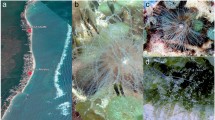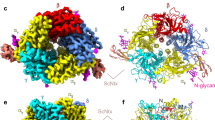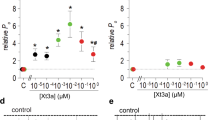Abstract
Blocking agents of high selectivity are crucial in defining both physiologically and biochemically the molecular components that control membrane excitability. To obtain such probes for voltage-dependent ion channels, we have examined the venom of several American scorpions for the presence of polypeptide neurotoxins having the required properties. We report here that using voltage-clamped giant axons of the squid Loligo vulgaris we have identified in the venom of the scorpion Centruroides noxius Hoffmann a polypeptide (fraction II-11) that specifically depresses the peak permeability of K+ channels without affecting their voltage-dependent open–close kinetics. The venom also contains a polypeptide toxin (fraction II–10) that specifically depresses Na+ peak permeability with only minor effects on the activation–inactivation kinetics. Furthermore, the physiological effects of the whole venom on the squid giant axon can be assigned quantitatively to the combined action of the two polypeptides.
This is a preview of subscription content, access via your institution
Access options
Subscribe to this journal
Receive 51 print issues and online access
$199.00 per year
only $3.90 per issue
Buy this article
- Purchase on Springer Link
- Instant access to full article PDF
Prices may be subject to local taxes which are calculated during checkout
Similar content being viewed by others
References
Possani, L. D. et al. Biochim. biophys. Acta (in the press).
Possani, L. D., Dent, M., Martin, B., Maelicke, A. & Svendsen, I. Carlsberg Res. Commun. 46, 207–214 (1981).
Wanke, E., Carbone, E. & Testa, P. L. Biophys. J. 26, 319–324 (1979).
Carbone, E., Testa, P. L. & Wanke, E. Biophys. J. 35, 393–413 (1981).
Schwarz, J. R., Ulbricht, W. & Wagner, H. H. J. Physiol., Lond. 233, 167–194 (1973).
Koppenhöfer, E. & Schmidt, H. Pflügers Arch. ges. Physiol. 303, 133–149 (1968).
Gillespie, J. I. & Meves, H. J. Physiol., Lond. 308, 479–499 (1980).
Catterall, W. A. A. Rev. pharmac. Tox. 20, 15–43 (1980).
Okamoto, H., Takahashi, K. & Yamashita, N. Nature 266, 465–468 (1977).
Mozhayeva, G. N., Naumov, A. P., Nosyreva, E. D. & Grishin, E. V. Biochim. biophys. Acta 597, 587–602 (1980).
Cahalan, M. D. J. Physiol., Lond. 244, 511–534 (1975).
Nonner, W. Adv. Cytopharmac. 3, 345–352 (1979).
Narahashi, T., Shapiro, D. I., Deguchi, T., Scuka, M. & Wang, C. M. Am. J. Physiol. 222, 850–857 (1972).
Romey, G. et al. Biochem. biophys. Res. Commun. 64, 115–121 (1975).
Rochart, H., Bernard, P. & Couraud, F. Adv. Cytopharmac. 3, 325–333 (1979).
Maelicke, A., Fulpius, B. W. & Reich, E. Handbook of Physiology Part 1 (ed. Kandel, E. R.) 493–519 (American Physiological Society, Maryland, 1977).
Maelicke, A., Fulpius, B. W., Klett, R. P. & Reich, E. J. biol Chem. 252, 4811–830 (1977).
Kang, S. & Maelicke, A. J. biol. Chem. 255, 7326–7332 (1980).
Hodgkin, A. L. & Katz, B. J. Physiol., Lond. 108, 37–77 (1949).
Author information
Authors and Affiliations
Rights and permissions
About this article
Cite this article
Carbone, E., Wanke, E., Prestipino, G. et al. Selective blockage of voltage-dependent K+ channels by a novel scorpion toxin. Nature 296, 90–91 (1982). https://doi.org/10.1038/296090a0
Received:
Accepted:
Issue Date:
DOI: https://doi.org/10.1038/296090a0
This article is cited by
-
Kv1.3 channel blockade with the Vm24 scorpion toxin attenuates the CD4+ effector memory T cell response to TCR stimulation
Cell Communication and Signaling (2018)
-
A fusion protein containing a lepidopteran-specific toxin from the South Indian red scorpion (Mesobuthus tamulus) and snowdrop lectin shows oral toxicity to target insects
BMC Biotechnology (2006)
-
Recombinant scorpion insectotoxin AaIT kills specifically insect cells but not human cells
Cell Research (2002)
Comments
By submitting a comment you agree to abide by our Terms and Community Guidelines. If you find something abusive or that does not comply with our terms or guidelines please flag it as inappropriate.



